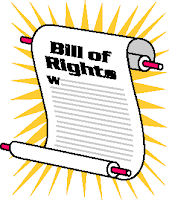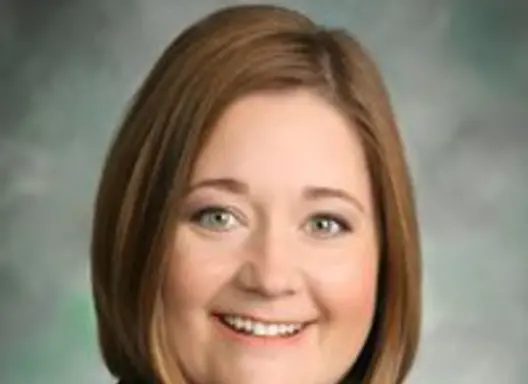The Bill of Rights in the U.S. Constitution begins with religious freedom: Congress shall make no law respecting an establishment of religion, or prohibiting the free exercise thereof... (Of course, the primacy of these phrases is due to the first two amendments proposed by Congress failing of ratification in the state legislatures, so what was to have been the third amendment got elevated to first. I'm trying to execute a rhetorical flourish here, so please keep your historical accuracy to yourself.)
(And yes, I do occasionally contemplate groups of angry white men proclaiming their 4th Amendment right to brandish automatic weapons, as well as nervous white-collar defendants pleading the 7th.)
We get very little help, alas, from the members of 1st Congress, in elaborating the meaning of those religious freedom phrases, including words like "exercise" and even "religion" (Witte and Nichols 2016: 81-95). For much of the U.S. history, the Supreme Court has wrestled with articulating a standard for deciding cases when religious people, however defined, claimed exemption from laws. In
Reynolds v. U.S. (1878), dealing with the Mormon practice of polygamy, Chief Justice Morrison Waite argued that religious people were never entitled to exemptions from otherwise-constitutional laws:
To permit this would be... in effect to permit every citizen to become a law unto himself. Maybe, but by the 1940s, when the religious freedom clauses began to be applied to state laws, Waite's non-standard was widely thought to be inadequate. In
the 1963 case of Sherbert v. Verner, dealing with a Seventh Day Adventist denied unemployment compensation benefits for refusing to work on Saturday, the Court required a religious exemption because the state (South Carolina) had failed to demonstrate a "compelling state interest." Even when the government demonstrated such an interest, they would also need to prove that denying religious exemptions was the "least restrictive means" possible to attain that interest.
In 1990, a new Justice Antonin Scalia wrote a decision moving the standard back towards Reynolds. In deciding against members of the Native American Church whose ceremonial use of the drug peyote ran afoul of Oregon narcotics laws, Scalia wrote: We have never held that an individual's religious beliefs excuse him from compliance with an otherwise valid law prohibiting conduct that the State is free to regulate. At another place he used the phrase a neutral, generally applicable regulatory law, which led to this standard being dubbed "general applicability." Even the general applicability standard, though, was not enough to save a Hialeah, Florida ordinance prohibiting animal sacrifices, which the Court found had been specifically aimed at thwarting the Santerian Church of Lukumi Babalu Aye.
 |
| The Supreme Court building in 2018 |
The general applicability standard has not
worn well (Volokh 2015). It was never overruled by constitutional amendment, but a bipartisan
effort in Congress restored the compelling state interest for federal law in
the Religious Freedom Restoration Act of 1993. Ironically, social conservatives who revere Scalia have proven the most restive; their efforts
described by Goldford (2012) to include orthodox forms of Christianity in the
original meaning of the Constitution have shifted in these changing times to... claiming religious exemptions from generally applicable laws. In 2015, the Court found 5-4 in Hobby Lobby v. Burwell that the religious owners of the Hobby Lobby Corporation were burdened by the contraceptive coverage requirement in the Affordable Care Act. The Obama administration's arguments for a compelling state interest in providing access to health care were rejected, as well as their proposals for any alternative means to achieve it. (See the companion case of Wheaton College v. Burwell, also a 5-4 decision, finding a religious college was burdened by filing a form to get exempted from the contraceptive provision.)
Most recently, there
are last month's 5-4 decisions in Roman
Catholic Diocese of Brooklyn v. Cuomo and Agudath
Israel v. Cuomo, which found the State of New York's pandemic
restrictions on public gatherings improperly applied to attendance at religious
services. (See Dawid
2020, Barnes
2020.) Another decision is expected soon on a similar case from California
(cf. Liptak
2020).
Part of the problem with the pandemic cases has been the level of nuance in state restrictions. They can read like Euclidean zoning codes, making hair-splitting distinctions that leave them vulnerable to attack on grounds of favoritism. The Diocese of Brooklyn complained in their petition to the Court they were subject to onerous fixed-capacity caps while [the state was] permitting a host of secular businesses to remain open in "red" and "orange" zones without any restrictions whatsoever.... The result is that Target and Staples can host hundreds of shoppers at a time, and brokers can spend 40 hours per week working and hosting customers in poorly ventilated office buildings, but Catholics cannot attend a 45-minute Mass. When Governor Andrew Cuomo defended the measures because some Catholic and Jewish services had become super-spreader events, the plaintiff organization Agudath Israel said he had drawn targets on a map over neighborhoods of a discrete religious minority (all quotes from Barnes 2020; see also Liptak 2020).
(The New York orders' alleged discrimination against religious exercise was disputed. Justice Sonia Sotomayor, in her dispute in Diocese of Brooklyn, argued New
York treats houses of worship far more favorably than their
secular comparators, noting that the orders closed movie theaters, concert venues, and sports arenas, while houses of worship only had to limit attendance. Surely the Diocese cannot demand laxer restrictions by
pointing out that it is already being treated better than
comparable secular institutions.)
 |
COVID Cases by county, New York and environs
(Source: Johns Hopkins University of Medicine. Used without permission.) |
Unlike Hobby Lobby and Wheaton College (Sullivan 2014), the pandemic cases don't involve arguably unresolvable issues of whether the plaintiffs are exercising religion; they unquestionably are. The issue in Diocese of Brooklyn and Agudath Israel is whether there is a compelling state interest. The unsigned majority opinion doesn't reject outright the presence of public health considerations during a pandemic that has officially killed 300,000 Americans and likely has killed 100,000 more. It is also true that America has fared far worse during the pandemic than other industrialized countries, largely because we've been unwilling to impose more stringent restrictions. (The chart at the bottom of the post compares coronavirus death rates among advanced industrial democracies. The United States, an outlier in terms of religious devotion, is not the poorest-performing of the group when it comes to keeping its citizens alive, but many of our less religious peers have done much better.) And some individuals, like health care workers and those with disabilities, are particularly at risk when the contagion is not controlled (Mogul 2020, Wilder 2020).
Yet, the decision argues, The restrictions at issue here, by effectively barring many from attending religious services, strike at the very heart of the first amendment's guarantee of religious liberty. If controlling a deadly pandemic is not a "compelling state interest," what state interest could possibly qualify? Does the First Amendment now require religious exemptions to all laws? I'm proud to be an American, where at most I know I'm free?
Just like state governments struggling to rationalize pandemic restrictions, the Supreme Court needs for its own and everyone else's sake to avoid appearing arbitrary and capricious in articulating standards for its decisions. With certain notable exceptions, including the Santeria case, the free exercise clause has been interpreted in whatever way favors traditional majority culture: yes to conservative groups wanting exemptions from public health regulations, yes to evangelical business owners who don't want to insure their employees if they have to include contraception, yes to evangelical bakers who don't want to make wedding cakes for gays, no to Native American peyote users or cemetery owners, no to Mormons (at least in the 19th century). Libertarianism for me, authoritarianism for you?
Traditional majority culture has found a home in the Republican Party, as witness overwhelming white evangelical support for Republican candidates from Reagan to Trump (Gjelten 2020); meanwhile it responds to demographic and cultural change by going into a defensive crouch. "It pains me to say this," Justice Samuel Alito told the Federalist Society, "but in certain quarters, religious liberty is fast becoming a disfavored right" (Barnes 2020). Disfavored by whom? That sounds too much like President Trump trying to rediscover the War on Christmas. Five of the six Republican appointees to the Court made up the majority in these decisions. Whose favoritism matters?
In a 2014 blog post, Prof. Winnifred Fallers Sullivan of Indiana University highlights the riskiness of all free exercise jurisprudence:
The need to delimit what counts as protected religion is a need that is, of course, inherent in any legal regime that purports to protect all sincere religious persons, while insisting on the legal system's right to deny that protection to those it deems uncivilized, or insufficiently liberal, whether they be polygamist Mormons, Native American peyote users, or conservative Christians with a gendered theology and politics. Such distinctions cannot be made on any principled basis. (Sullivan 2014)
Protection versus denial is a binary choice, and like most binary choices it is a false one. We can and should agree to protect the religious liberty of all, but take into account the social costs of exercise. Native American Church members should not be driving cars while impaired by peyote, and in fact the controlled nature of their ceremonies prevents that. Religious exercise that prevents non-participants from accessing health care is a different matter, though we could address the flaws in the health care system that give rise to the question in the first place. Religious exercise that puts non-participants at significantly higher risk of contracting a deadly disease should not be arguable... unless we're claiming that protection of religious liberty can never be limited.
Without a "principled basis" for deciding free exercise cases, and consistent application of those principles, what are we left with but the exercise of power by one group over another? "Religious freedom" is a rather lofty phrase for that.
Thanks to my colleague Dr. Meira Kensky for pointing me towards the piece by Sullivan, and other helpful suggestions.
SEE ALSO: "Rights and Our Common Life," 26 August 2015
PRINT SOURCES
Dennis J. Goldford, The Constitution of Religious Freedom: God, Politics, and the First Amendment (Waco: Baylor University Press, 2012).
John Witte Jr. and Joel A. Nichols, Religion and the American Constitutional Experiment (New York: Oxford University Press, 4th ed, 2016)
DATA
COUNTRY COVID
DEATHS PER 100,000 % REL V IMP
Belgium 18,054 158 11
Italy 65,011 108 21
Spain 48,103 103 22
United Kingdom 64,402 97 10
United States 301,006 91 53
France 57,911 86 11
Sweden 7,514 74 10
Switzerland 5,692 67
9
Netherlands 10,168 59 20
Portugal 5,649 55 36
Austria 4,648 53 12
Ireland 2,126 44 22
Canada 13,553 37 27
Germany 22,475 27 10
Denmark 950
16 9
Finland 466 8 10
Norway 393 7 19
Australia 908 4 18
Japan 2,649 2 10
South Korea 600 1 16
SOURCES: New York Times interactive “Coronavirus
World Map: Tracking the Global Outbreak,” 12/15/2020; Pew Center for
Religion and Public Life, “The
Age Gap in Religion around the World,” 6/13/2018















